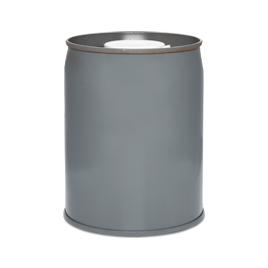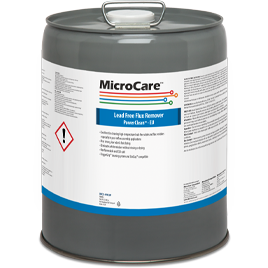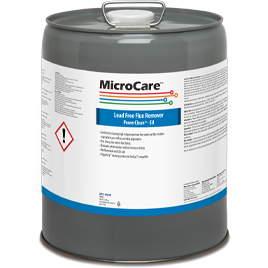Lead Free Flux Remover - PowerClean™ Bulk — Europe
Product Information
PowerClean Lead-Free Flux Remover removes hard-to-clean lead-free solders and fluxes
Applications:
- Eliminates white residue commonly found with high temperature lead-free fluxes
- Use for defluxing, degreasing, cleaning connectors, removing light oxides and cleaning flux-covered pallets
- Easily flushes away lead-free residue, oils, inks and acrylic conformal coatings.
- Best choice for cleaning during rework and repair because it cleans and dries fast
Features:
- Produced, packaged and labeled to meet European regulations
- No residue/no rinsing
- Very strong cleaner – test on plastics before wide-scale use
- Kb Value: 115 (very strong)
- Fast drying for speedy cleaning
- Chemical Family: HFC blend
- Nonflammable for added safety
- Low odor for a better work environment
- VOC Content – Bulk: 1017 g/L
- RoHS/WEEE/REACH/ EPA SNAP compliant
- NSN: 6850-01-361-0867
PowerClean™ Lead Free Flux remover is strong but the aroma isn’t. Plus, it’s so powerful it doesn’t need much elbow grease or scrubbing to get the boards clean. It is not suitable for use in heated cleaning systems.
Product Details
Product Image |
Part Number | Package | Weight | Size | Technical Data Sheet | Safety Data Sheet |
|---|---|---|---|---|---|---|

|
PW3G MCC-PW3G | Mini-pail | 4.5 kg 10 lbs. | 3.8 L 1 Gallon | ||

|
PW3P MCC-PW3P | Metal Pail | 22.7 kg 50 lbs. | 17.5 L 5 Gallons |
| Part Number | MCC-PW3G | MCC-PW3P |
|---|---|---|
| Package | Mini-pail | Metal Pail |
| Weight | 4.5 kg 10 lbs. | 22.7 kg 50 lbs. |
| Size | 3.8 L 1 Gallon | 17.5 L 5 Gallons |
| Technical Data Sheet | ||
| Safety Data Sheet |
Scroll
| Appearance | Clear, colourless liquid |
|---|---|
| Odor | Slight, Etheral |
| PEL (ppm, 8-hr TWA) | 200 |
| Boiling Point | 42°C / 107.6°F |
| Chemical Family | HFE Blend |
| Evaporation Rate | Fast |
| Cleaning Strength (Kb) | 115 |
| Active Ingredients | Hydrofluorocarbons and trans |
| Flashpoint | None |
| Global Warming Rating (100yr) | Medium |
| VOC Organic Content (g/L) | Not available |
| Ozone Impact | Zero |
| REACH & ELINCS Compliant | |
| RoHS & WEEE Compliant | |
| Safety Rating | Non-flammable |
| Specific Gravity | 1.32 |
| Surface Tension | Not available |
| Vapor Density | Not available |
| Viscosity | Not available |
| Vapor Pressure @ 20ºC | Not available |
- Is MicroCare REACH Registered? Which Cleaners Can I Use in Europe?
- What is Causing White Residue on my PCBs?
- What Is a Kb Value? What Does It Tell Me About My Cleaning Fluid?
- Which Is the Mildest MicroCare Cleaner?
- Are There Toxicity Issues with Trans?
- What’s the Best Way to Dry a PCB on the Benchtop?
- Which MicroCare Aerosol Cleaner is the Strongest?
- What's a TriggerGrip™ and How Does It Help Me?
- What's the Best Way to Clean PCBs at the Benchtop?
- Is Dip-and-Brush Cleaning Good for Cleaning Circuit Boards?
- How Can I Cost-Justify the Trigger Grip System?
- How Do I Use the TriggerGrip™ System?
- How Long Will A TriggerGrip™ Last?
- Why Does MicroCare Have So Many Different Benchtop Cleaning Choices?
- How Long Does a Can of MicroCare Flux Remover Solvent Last?
- How Long Does a Can of MicroCare Cleaning Fluid Last?
- Which Cleaner Works Best on Lead-Free Fluxes and Pastes?
- What's Best for Cleaning RMA Fluxes and Pastes?
- What's the Best Cleaner for 'No Clean' Solders and Pastes?
- Why Should I Clean 'No Clean' Fluxes and Pastes? Can I Just Skip the Cleaning and Save Some Money?
- Which Cleaner is Best at Removing Conformal Coatings?
- Which Cleaner Works Best on Light Grease, Oils and Other Lubricants?
- Which Cleaner Works Best on OA Fluxes and Pastes?
- What's Best for Cleaning Under Low Clearance SMT Components?
- What Is a Toxicity Rating (PEL, TLV, AEL)? Which Solvent Is the Safest (Has the Least Toxicity)?
- Are There Any IPA Replacement Cleaners?
- How Do PCB Cleaning Pens Work?
- How Do I Choose a Contact Cleaner?
- What are the Benefits of Better Quality Stencil Rolls?
- Any NSN Numbers Assigned to MicroCare Cleaning Products?
- How Do I Clean Fiber Optic Components on PCB Circuit Cards?
- My StatZap™ No Longer Fits on My Micro•Blast™ or Big•Blast™ -- What's Up With That?
- What Can I Use to Clean Computer Keyboards, Cabinets and Housings?
- Which Cleaner is Best at Removing Silicones?
- What Cleaner Can I use for Removing Marking Inks, Sharpie Inks and Pen Ink?
- Which Cleaner Is the Best to Remove HumiSeal 1B31 (Acrylic Conformal Coating)?
- How Can I Remove Toner Off Laser Printers and Copiers?
- Which Flux Remover Is Best on Ceramic Hybrid Circuits?
- Which Is the Best SMT Stencil Cleaner?
- Which Cleaner Is Best to Use in Automated Stencil Printers?
- Which MicroCare Products Meet Mil-spec Cleaning Requirements?
- Which Cleaners Work Best in Ultrasonic Tanks or Dip Tanks?
- Are MicroCare Products Approved for Use in Clean Rooms?
- What Can I Use to Clean the Burned-On Fluxes in My Reflow Ovens and Wave Solder Machines?
- What Cleans Soldering Pallets and Frames?
- Is There a Cleaning Process to Remove Residues and Build-Ups on Wave Solder Machine Pallets?
- How Can I Heat the Reflow Oven Cleaner to Use in a Dip Tank?
- How Do I Dispose Empty Aerosol Cans and Pump Spray Bottles?
- How Can I Clean a Spray Fluxer in a Wave Solder Machine?
- Does MicroCare Have Any Replacements for HCFC-225?
- What's the Best Replacement for nPB Aerosols?
- Can I Get HCFC-141b Alternatives for Cleaning?
- Are MicroCare Products Safe or Hazardous?
- Are Any MicroCare Products Nonflammable?
- Do Flammable Cleaners Create a Hazard on the Rework Bench?
- How Can I Ensure My People Are Handling Chemicals Properly?
- My People Are Complaining About Solvent Fumes. What Can I Do?
- What Are the NFPA Ratings for the MicroCare Cleaners?
- Do I Need Gloves When Working With MicroCare Cleaners?
- What's the Shelf Life of MicroCare™ Cleaners?
- What Is the VOC Content of the MicroCare Flux Removers?
- What Are VOCs? Which MicroCare Products Contain VOCs?
- Which MicroCare Cleaners Contain VOCs?
- What Does It Mean to Be 'VOC Exempt'? Is the Chemical Still a VOC?
- Is Global Warming a Problem With Any MicroCare Products?
- Do MicroCare Aerosol Products Damage the Ozone Layer?
- Can I Get Refills for My Presaturated Wipes?
- Does MicroCare Sell Freeze Sprays and Dusters ('Canned Air')?
- What Can I Use to Clean Manual Stencil Printers?
- What Flat Wipes (Lint-Free Dry Wipes) Does MicroCare Offer?
- Are MicroCare Wipes ESD-Safe?
- What Is the Liquid Quantity of Cleaner in a MicroCare Package?
- Can I Get Stencil Wiping Rolls from MicroCare?
- What Is MicroWipe™ FP Stencil Wiping Paper?
- Does the Paper Quality on a Stencil Roll Make a Difference?
- What Are the Benefits of Choosing MicroWipe™ FP Paper Over Ordinary Stencil Rolls?
- What's the Technology Behind the SMT Printing Quality Improvements from FP Stencil Rolls?
- How Does the Vacuum Feature Affect My Paper Choice?
- Can I Get Stencil Wiping Rolls in Custom Sizes?
- Does MicroCare Have Competitive Stencil Roll Pricing?
- Do MicroCare Cleaners Meet the F-Gas Rules in Europe?
- Which MicroCare Cleaners Can I Use in Australia?
- Which MicroCare Cleaners Can Be Used in Japan?
- Which Cleaners Can be Used in California?
- How Do I Measure PCB Cleaning Results?
- What's a 'Wetting Index' and Why Is It Important In Cleaning?
- What Does 'Hygroscopic' Mean? Why Is It Important?
- What is an Azeotrope? Why Are They Important?
- MicroCare Lab Services for Critical Cleaning
- How-to: Using the TriggerGrip PCB Cleaning Tool
- Solder Paste and Flux Cleaning Results Revealed
- Cost-Cutter: Seven Ways to Save Money Cleaning PCBs
- How-to Connect and Disconnect the TriggerGrip Cleaning Tool
- Best Practices: Cleaning During PCB Rework and Repair
- MicroCare Partners in RENEX Hand Soldering Championship 2019
- Mike’s Radio Repair Demonstrates the TriggerGrip™ Cleaning System
- MicroCare Leads the Way on Worker Safety and Regulatory Compliance
- MicroCare Critical Cleaning Experts
- The MicroCare Reliable Care Way
- Azeotropes Explained
- Our Chemistries and Expertise Set Us Apart - APEX 2020 Interview
- Jumbo Sized Flux Removers Save Money
- Portable Flux Remover Pens are a Convenient Time Saver
- Static Dissipative Wipes Clean Without Worry
- Cost Saving Products for Benchtop Cleaning
- Case Study #15 — Cleaning Mixed Flux Residues from PCBs
- Going Green with Vapor Degreasing
- Removing PCB Conformal Coatings
- Use Toxicity Ratings to Help Ensure Worker Safety
- The Meaning of Kb Value in PCB Cleaning
- Why Clean a No Clean Flux
- TriggerGrip InfoGraphic
- Flux Remover Selection Guide
- The Importance of Drying in PCB Cleaning
- All Electronics Cleaning Wipes Are Not Created Equal
- 4 Types of PCB Contamination and How to Remove Them
- An Early PCB Cleaning Plan Leads to Manufacturing Success
- Cleaning and Drying Before Conformal Coating: Why It’s Important
- MicroCare Offers IPA Alternative Cleaners
- Modern Electronics Require Updated Cleaning Methods
- Modern PCBA Cleaning: Methods to Improve Reliability
- Ensure Contact Cleaner Compatibility with Today’s Complex Electronics
- Safer Cleaning Choices Replace nPB in Aerosols for Worker Safety
- Circuit Board Design & Cleaning Evolves to Support Down-Hole Logging Technologies
- Stencil Wiping Fabric Improves Stencil Printer Through-Put

